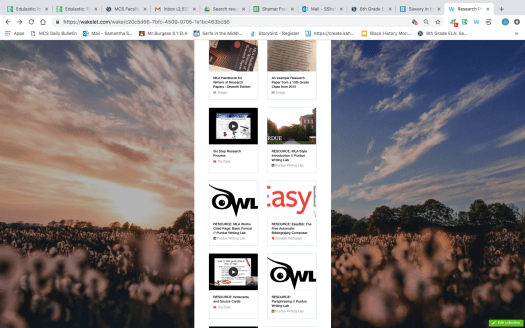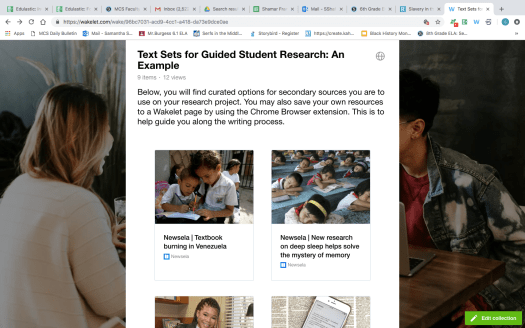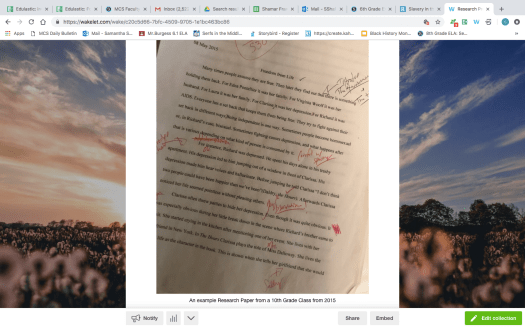Transforming the research process for 21st century learners
In a world where most research is now conducted online, students need to learn new skills to be discerning with their sources. English teacher Samantha Shaffner explains how Wakelet can help
My students no longer live in a world where learning how to research means hours spent in library stacks or getting to grips with the Dewey Decimal System. Instead, they use online resources, like YouTube, that they already know how to consume. Instead of casting my students out into the wild world of the internet to form bad habits, I use Wakelet to curate and organize selected resources for them. I then guide them to develop their own collections before finally turning them loose when they have a firm understanding of how to vet online resources.
As much as my students love using Wakelet independently to create visually appealing collections of work, I appreciate that the platform allows me to see how a student’s effort and thought-processes change as I help them develop skills. In a world of online resources, I can develop research projects and help students in real time rather than asking them to spend hours in a library away from the classroom.
First, I control the content my students access by selecting specific articles. Then I help them by creating and maintaining collections on the writing process itself. Standards for any project can be published in a collection for students to use. Wakelet collections act like a notebook for students to quickly reference later. For comparison, below is a picture of my MLA handbook, dog ears and all. Websites like Purdueowl.com and others provide the same information, which can be curated into Wakelet collections for students to use and interact with in the classroom with teacher support as well as within their independent studies and home learning.

Making the most of time in the classroom
Trips to the library to complete research projects are time consuming and, let’s be honest, not the best use of time for busy students at the start of their academic writing journey. Wakelet lets me deconstruct the writing process into tangible steps for my students to follow on a visually appealing platform that allows me and them to draw information from anywhere.

In the student research project section of my profile, there’s a Wakelet collection called ‘Text sets for student research project’. Here I carefully curate credible articles for students to choose from. These articles deal with similar themes and topics, for example the genre and study of Dystopian Young Adult Literature. As students become more comfortable with the research process, they can begin to build these text sets themselves.
Even so, scaffolding this process has proven to be a best practice. There are many reasons for this but, mainly, students are seamlessly led to text that still allows them a degree of ‘voice and choice’ but also eliminates the large possibility that they may wander away from primary sources to Wikipedia, especially when confused about the research process in their formative high school years.
Saving resources in just two clicks
In the classroom, my students use Wakelet’s browser extension to save their sources. The extension allows me and my students to quickly organize open tabs into collections for later use. This feature streamlines the research process by making it possible to drag all of your tabs into a collection or number of collections that align with our project goals and learning objectives. By eliminating the need to email yourself every source and page number, risking typos and opening up room for mistakes, the browser extension saves time and improves the overall quality and integrity of the project.
Moreover, using Wakelet, you can seamlessly drag your resources via their tabs into collections created for your personal research project as a student (across all disciplines and grade levels). As a teacher, this feature has been incredible and I can only imagine what we can accomplish in my English Language Arts classroom with it.
A new way to provide feedback

As you can see in the image above, before technology was effectively implemented in secondary classrooms, giving feedback on writing was a rather shallow process. A piece of paper with some numbers jotted down, some red lines, and some comments is not enough for students to receive the quality and quantity of feedback needed to be successful in high school, college, and beyond. In my experience, hands on guidance is the best way to ensure that my students develop good writing and research habits that will serve them throughout their academic careers.
Hosting resources that outline the various processes in curated Wakelet collections is an excellent way to provide an electronic container for research. Teachers can create assignments around these resources to walk students through the different processes i.e. writing introductions, creating a list of works cited, paraphrasing, in-text citations, finding sources, the writing process etc. Students can always have these resources in their electronic ‘backpacks’ so to speak and teachers can save and archive their collections to tweak and use in school years to come while also adding to them as technology and standards advance over time.
Libraries are irreplaceable, but students must be able to navigate digital resources to thrive as writers and researchers. This year, my students will be learning how to develop a research project piece-by-piece while I provide on-the-spot support and guidance. I’m excited to continue developing these resources so that I can continue to improve and implement them for years to come.
Samantha is an English Language Arts Teacher @2kschool, Columbus, OH as well as a Wakelet Ambassador. She is also Program Designer/ELA Teacher within charter school setting; creating district wide benchmark exams for middle school ELA teachers; analyzing data to create digital assessments and other curricula using cutting edge educational tech tools and applications
Wakelet profile: @SamanthaShaffner9061
Twitter: @SamanthaShaffn2
LinkedIn: Samantha J. Shaffner

